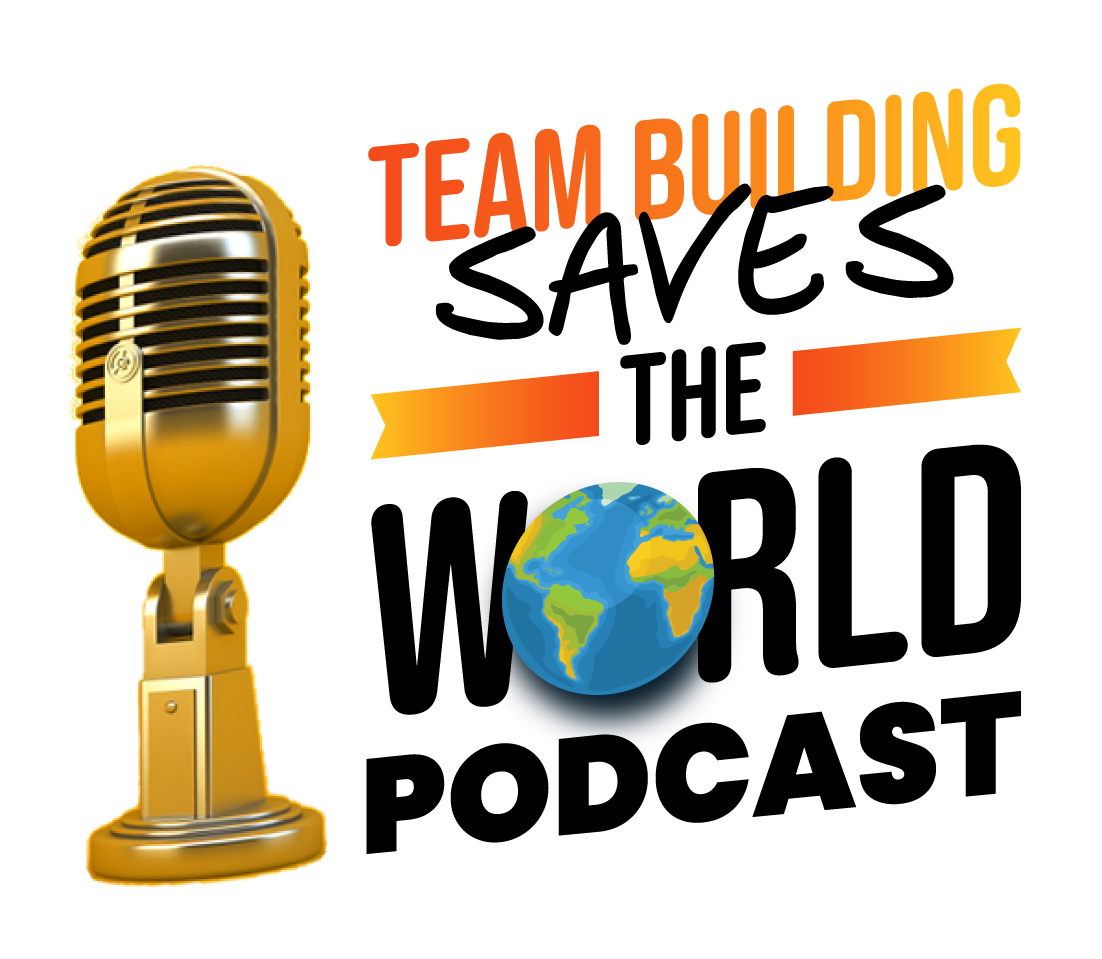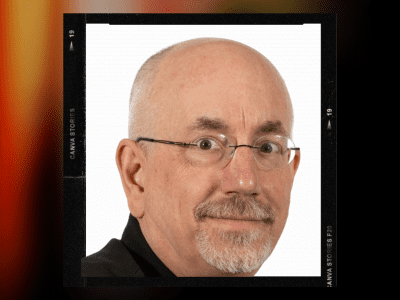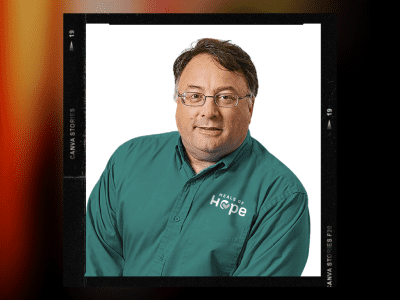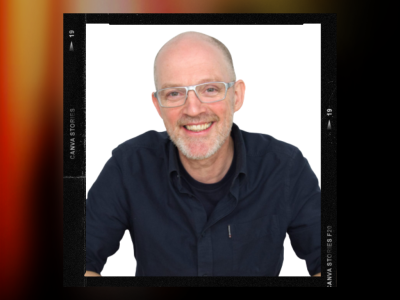Learning Style Savviness
w/ Tyler Hayden
Use the buttons above to listen now.
Transcript - Learning Style Savviness
Rich Rininsland: Hello team. It’s me. Your old friend Rich Rininsland host of team building saves the world. And I have a question for you. Do you think of yourself as a cognitive learner or would you say you were more tactile in your learning?
I’m only asking because today we’re talking about learning styles with Hall of Fame speaker and team building facilitator and expert Tyler Hayden. But before we do, I have to share some love with all of my support as a TeamBonding. If your team is ready to experience teamwork through the power of play, the visit TeamBonding.com to learn more now.
Team get ready to learn about learning. With author and former Chicken Farmer Tyler Hayden. Tyler, thank you so much for coming on. I appreciate you being here, man.
Tyler Hayden: Rich, I’m stoked to be here. We are gonna save the world today. We are. We are. Who’s who? This is like, yeah. How do you not say yes to? Like, Hey, would you like to come and save the world with team building? The answers yes.
Rich Rininsland: So I, I usually like to start the podcast in one specific way for my team out there, which is just to get to know you a little bit better before we dive a little more deeply
Tyler Hayden: Cool.
Rich Rininsland: Into the conversation points. But I gotta say, I did a little background on you. I did a little search before we began.
Tyler Hayden: Okay. How do you start, dark web or regular web? Which, where did you look?
Rich Rininsland: Let’s not go into that because somebody might be listening.
Tyler Hayden: Okay, good. Thank you.
Rich Rininsland: But no, let’s, how do you start from chicken farming? To becoming a Hall of Fame speaker and team building facilitator and expert.
Tyler Hayden: You know what you, I, I started this business, it was crazy because I graduated from university and when I graduated I had a degree in outdoor and environmental education, so rock climbing, hiking, and canoeing.
Rich Rininsland: Nice.
Tyler Hayden: My dad was permanently disabled and I wanted to start a business or I decided to start a business close to home so that I could help to take care of him.
Yeah, so I started like an Outward Bound company and I was making like 300 bucks a weekend to take a group of people out rock climbing. And then I got asked, I started the largest student run. Student Leadership Association in North America when I was in high school and I got invited to come and speak at a local high school, and they gave me the same $300 for an hour of my time, and I got to crack jokes and do the stuff that got me typically kicked outta class.
Rich Rininsland: Nice.
Tyler Hayden: And it was just a, like, it was a no brainer at that point. I just, I fell in love with speaking and I fell in love with team engagement and I was able to marry the two together in the, in the youth world for the first in, in the school assemblies for the first probably 10 years of my life and then into the corporate world after that.
So. There’s the quick and dirty
Rich Rininsland: Nice. And as I’ve also,
Tyler Hayden: there’s chickens along the way. Chickens and bees along the way.
Rich Rininsland: Well, as I also noticed in your, in the research you are quote Canada’s answer to alternate energy. Close quote. Yeah. I’m, what does that mean and what does it mean in context to working with teams? For you?
Tyler Hayden: Sure. So I, it was coined by a, a meeting planner, so I do a lot of I do a lot of keynote stuff. Yeah. So a lot of my team engagement stuff is, I’ll have a room of 200 or 8,000 people and we’ll do team building together along with high energy stories, that kind of stuff. I am, I’m just like from word go, I’m fast paced.
So that’s, that’s where all that came from. Okay. And our, and our activities, our games and stuff that we do are really, I mean, they’re laser focused in a way that gets. Teams engaged. So have a really unique way of deciding on which activity to use. Right. And it just turned into like high octane fun because by looking at the learning profile of the folks who are in the room, we’ve really been able to create some great success for meeting planners.
So that’s where High Energy Canada’s answer alternative energy came from. ’cause it’s just high octane fun and development from start to finish. So yeah, that’s where that came from.
Rich Rininsland: Fabulous. But how important is that to you, do you think? I mean, for for a facilitator, does it, do you think that someone like you, and I have to admit you and I, it sounds like we’re on pretty much the same wavelength, which is when you’re on, you’re on, and you know, it doesn’t matter what’s happening to you personally, physically, what have you.
Tyler Hayden: Right.
Rich Rininsland: All that will come back once the event is done.
Tyler Hayden: A hundred percent. A hundred percent.
Rich Rininsland: How important is that to you, do you think, for a successful team building facilitation?
Tyler Hayden: Yeah. For, so from a facilitator’s standpoint. Right. You know, I think that the way I, the way I, the way I explain it to new trainers is, you know, if you look at the aggregate of the cost of the people that are in the room you know, and if you have a thousand people in your room, you know, each, let’s say they’re nurses and they’re making $30 an hour, well, that’s 30,000 bucks.
That’s what that hour costs. Okay, so there’s some pressure. So you have to turn all of that other stuff off and you really have to make sure you deliver. ’cause that, I mean, that’s just the, that’s just the unit cost of what we’re delivering. And when we look at the you know, the opportunity cost of what we can create from that point if we deliver well, the responsibility is huge and the opportunity to create some really cool things in our communities and in our businesses just begins to skyrocket.
So I think that’s. You know, when I look at those two things, that’s, that’s, that’s the important part when you’re working with trainers and helping them to understand what they do.
Rich Rininsland: And as I’ve seen you have worked, whether it’s with CEOs of Fortune 500 companies or whatever, whatever the Canadian equivalent of that actually is, and you work and you work with like shop floor employees.
Tyler Hayden: So, a hundred percent. Yeah. The, I work with so internationally, so I work with like the YPO, the WPO. Mm-hmm. I work with entrepreneurs. I work with Pratt Whitney’s. I’ve worked with the, you know, the subways of the world. I help to work, whether it’s with their, their frontline managers or their C-level managers who, whoever is kind of in the room.
Nice. I’ll work with all of them.
Rich Rininsland: Is there a difference in how you handle the engagement with them though? And do think there needs to be
Tyler Hayden: Yeah, the content becomes a little different. Okay. You know, I’m a firm believer that team building is what we do with people, not two people. So the, here I’ll show you my, I’ll show you one my favorite little graphics.
So team building is what we do with people, not to people at the end of the day. And, and being able to understand that. You know, when people come in the room, you have to be, you have to be culturally connected and it has to provide value at the end of the day. I’ve been in this business for 29 years.
You know, initially a lot of the team building stuff was about just having fun, you know, and it was about, you know, we were hiring recreation people to come in and, and to provide a team building experience. But what’s happened over the years is that we’ve had to really sharpen our tools and really understand.
Stand not only the fun side of it, but we have to deliver on those business objectives. So any good team event means starting with looking at what the strategic objectives are what their sales strategies are, you know, what are we looking at from you know an employee retention point of view.
What are our values? All those things. And getting clear with what the educational objectives is. So whether you’re working with the C-level folks or whether you’re. Working on the shop floor, they all have learning objectives that they need to look at. And, and another one of my favorite quotes is it’s good team building is good team learning.
Excellent. You know, and when we’re able to provide a great learning environment and one that aligns with the people in the room, then we can start to move the needle with inside the organization.
Rich Rininsland: So lemme just ask you from what you’ve seen through your experience, what, yeah. Is there a formula for creating a successful team?
Tyler Hayden: Yeah. So there, there is, I mean, we, so I wrote, I’ve written 29 books, I think 28. 29. 29. Yeah. I’ve got another one on the go.
We one, one of the things I wrote about, I, I was looking at some research, so Mihaly Csikszentmihalyi, who’s the, he wrote Flow theory. I dunno if you’ve run across that. Super cool. I was reading about flow Theory. He’s a, you know, a cool psychologist. All about how the brain works, how about like peak performance, that kind of stuff.
And then I was doing some reading from Howard Gardner, who is a Harvard professor who talks about multiple intelligences. And to, when I was reading those two things, I got to thinking about how they intersect and I came up with a tool called Multiple intelligence Quotient. So what it is, is we look at all of the learners in the room.
And we look at their learning style. Okay, so Howard Gardner talks to, there’s eight different learning styles. There’s mathematical logical there’s interpersonal, there’s linguistic, there’s naturalistic, there’s interpersonal, there, eight different learning styles. If, if we could look at kind of what the common learning styles are for those teams. So for example, we’re working with a sales team, interpersonal intelligence reigns supreme within a sales team. Also mathematical logical. So when we start to design and suggest team building activities we start to look at activities that frame around you know, good communication stuff that’s happening.
Making sure that there’s collaboration ’cause that’s that interpersonal learning thing that they want to do. Okay. And if they’re mathematical, we wanna make sure that there’s some. Distinct, like you know, measurable points and not just like fluffy ones where everybody gets a purple ribbon. It’s like there’s a winner and a loser.
Like I was working with some project managers from Florida and this, this one project manager said to me, she said, Tyler, she goes, you know, I work with Type A aerospace. Yeah. You know where they technicians of some kind rocket scientists or something. And I said, well, they’re all mathematical logical.
And I, and she goes, I don’t know what to do with team building with them ’cause they don’t wanna do anything. So I gave her an activity. She tried it and it was exactly that. It was measurable, it was quick. It hit on all their learning outcomes, what they would look at. She wrote me the next day and said, Tyler, I need a second activity.
They’re hooked what you do next. And that’s the, I mean, that’s the key. So if you could really start to distill the folks that you’re working with and then be able to say, okay, how do they want to learn? And if I can, it’s, it’s like, dale Carnegie’s, how to Win Friends and Influence People, right?
Mm-hmm. People wanna talk about themselves. People want to do something that they want to do, right? Right. And that’s the most fun for them. And learning styles, multiple intelligence quotient is absolutely the way to make that work.
Rich Rininsland: What kind of game do you use in that kind of situation? I mean, what specifically would you, so for you don’t have to gimme, you don’t have to gimme the way the stores or anything NASA engineers.
Tyler Hayden: Totally. I will give you freebie. This is like, great. You can, yeah. This is probably one of my faves. It’s, it’s called commonalities. I mean, you’ve probably played it before where you have. You know, kind of a group of, you know, six or eight sitting at the table, you can do it with three. Mm-hmm. You have them sitting at a table together.
The only rule is, is they have to come up with as many commonalities that they share with the people in their room. And you have multiples of these tables and they have to come up with commonalities around like things you can’t necessarily see. Like we all have hair, we all wear glasses. Like it has to be like.
You know, we’ve all traveled overseas. We all drive pickup trucks, we’re all wearing thongs, whatever it is, right? And then whoever, whatever team has the most number of commonalities, you give them like a minute and a half to come up with as many as they can. They win fabulous prizes. And, and it was literally that simple.
She was looking for something just to start in the start of her meeting. Okay. Just to get people excited and, and and reenergized. So that’s. That’s it. That’s commonalities and it’s simple. And the reason they loved it is because it wasn’t fluffy. Yeah. It didn’t take too long. Right. The, the type A engineer does not want shit to take too long.
They just want like bang, bang, bang. Okay. They wanted to get it done and they wanna be able to measure the, and they wanna know that they’re better than the table beside them.
Rich Rininsland: There’s always the competition element.
Tyler Hayden: Right. So they loved it. They ate it up. That was, it was, yeah. It was, it was a win for her.
She had, yeah. Anyway, we kept, we kept working together. She’s got a lot more wins.
Rich Rininsland: So how do we take that same team dynamic that you were talking about? Yeah. And we take them from team building to team learning.
Tyler Hayden: Yeah. Yeah. How do I It is a journey, right? Right. Well, here’s the thing, you know what happens, A lot of organizations will host a retreat or they’ll have a Right.
An event. Mm-hmm. Right? And right on the schedule it says, team building. Well, first of all. Stop it. Like, stop writing that down. Okay. Because you’re making, you’re telling people like, oh, this is what we’re assuming we’re gonna do, and this is the only time that we do team building. Right? Team building is like a, it’s a continuous process.
It’s part of the flow of your business, so you, you literally begin to plan that for 24 7, 365, right? Mm-hmm. All your, all the opportunities to connect are times that we build our team. And that matters because that’s about building that engagement energy. It’s about how we engage people, how we get them to start to move forward.
So, you know, if we’re starting up a meeting. We do a little something there. If we’re doing a retreat, you know, we’re doing the, you know, the guitar builds for you know, for charity or we’re doing the bike builds for charity, right? ’cause we’re making a difference beyond the room that we’re in. We’re, we’re starting to do those types of things in a big way.
But it’s the little things that we do progressively along the way. Like I, when I coach and, and help managers to, to sharpen their saws, I’ll, I’ll get them to put 10 pennies in one pocket. And I’ll say, you know, it’s about the little things that you do during the day for your teams. And for every little thing you do to help to create a positive difference, move one of those pennies from your right hand pocket to your left hand pocket, and don’t stop until all 10 pennies are in your left hand pocket.
And nice that, that way that. The manager’s starting to build a like a practice of, of being positively responsible for their teams. And then by doing that, we begin to adjust the culture. And that’s how we begin to improve the, the engagement. I mean, we look at numbers right now. Gallup Poll is saying that active disengagement in the us this is from 2024 or January, is on the rise to 17 per 17%, and, and engagement is dropping to 20.
14 levels of 31%. You know, so the things that managers are doing to help to make a difference is they’re clarifying job expectations. They’re ensuring employees feel cared about at work, and they’re encouraging professional development. You know, all three of those things is team building. Yeah. You know, whether it’s professional development, whether it’s understanding job expectations and whether it’s showing that they’re cared about, that’s the things that we do every day.
As a, as a manager, as a leader, it’s not just that one moment that is on the agenda
Rich Rininsland: and active disengagement. Can you give us a definition of that? Is it something like, we’ve been talking about quiet, quitting over the past couple of years?
Tyler Hayden: Yeah. Active disengagement is like physically not showing up for work.
You’re actively like finding ways of not doing the work that you’re supposed to be doing, so like. Okay. It’s like teenagers when you ask them to cut the lawn, right. It’s like as active disengagement. You are talking,
Rich Rininsland: you are talking my story in so many ways,
Tyler Hayden: right? You’re talking my weekend. Yeah,
Rich Rininsland: yeah, yeah.
But yeah, so, okay. Do managers not realize how important they are to this process or to keeping the process going? Do you find, or I think they do.
Tyler Hayden: You know, it’s like managers are kind of like that hourglass. I mean, we’ve seen the hourglass, they’re right in the crux, like all the stuff that comes down from C level and all the stuff that comes up from the shop floor.
Right? Right. They’re at, they’re at that point and it’s just, they’re, it’s like they’re, it’s like a stranglehold, right? They’ve got all this pressure from the top and all this pressure from the bottom. I think sadly, organizations don’t place enough value on what our employee facing managers are doing, whether a manager, supervisor, whatever that is, right?
It’s the first place that we cut. And we say, okay, well we’re gonna add, you know, we’re gonna change our od, and now instead of having 20 people report to you, you have a hundred people reporting to, and it, and, and that, that kind of change really makes it impossible to be able to do your job. You know, whereas you look at the success of something like Savannah Bananas.
And how they’re starting to really change how you connect with your customer. We have to, we have to have that same type of shift within, inside of our organizations. You know, Savannah Bananas has shown that, you know, the customer’s important. You pay one thing and everybody comes in and they get a burger and they’re having a beer and they’re having a great time.
And we’ve got baseball. That’s kind of baseball, but not really, and it’s. You know, it’s fun and, and it’s okay to laugh. And, and, and, and as we start to look at our teams you know, we still have to do the work. I mean, we’re responsible to our shareholders and we’re responsible to the bottom line. And we’re responsible to our measurables.
But at the same time, how you get there doesn’t have to be a slog, right? It can be more Savannah banana. It can be. Authentically fun. It has to be fun. Okay. To that manager’s style. You know, it can be fun, it can be interesting, it can be engaging, it can be all of those things. And, and we want to do that.
I mean, we want to do that. I’m gonna show you one more slide. I’m gonna show you this. That’s fine. This is the reason why we’re doing it for all my, hold
Rich Rininsland: on. I’m sorry, Todd. Just for real quick second for all my team out there who’s just listening to this on the podcast, Tyler comes with his own memes. And he’s been flushing them on the screen,
Tyler Hayden: firing him up.
Rich Rininsland: Nice job
Tyler Hayden: we’re, I like it. We’re 65 over here. You know, like we’re looking at why we want engagement. It’s 20% higher sales. It’s 21% higher profitability, it’s 70% higher productivity, it’s 10% higher customer metrics, 40% fewer defects, 70%. Fewer safety incidences, 41% lower absenteeism. That’s why engagement matters.
When I work with managers, I tell ’em, you know, we don’t have a budget. I say, well, if you could reduce your claims to WCB to the Compensation Board, if you could lower your insurance risk, right. Wouldn’t it be? And And team Build. That’s team building does that, right? Okay. If you are having trouble finding employees, well, we’re talking 17% higher productivity.
If you have 10 people and you could make them more engaged, they’re gonna give you, let’s say, 10% more productivity. Okay, well, you got 10 people at 10% increase. Bingo, bango, that’s a full FTE. That’s an FTE. That’s one person working for you that you didn’t have to pay for.
Rich Rininsland: So for that mid-level manager right now who is out there and thinking, yeah, this sounds great, gimme, gimme one actionable strategy that they can use.
Tyler Hayden: Simply, I mean, so we got the 10 pennies. I gave you that one. Okay. Okay. Yeah. So, we’ll, I’m gonna give you two now, rich. So we’re gonna, we’re gonna open up the faults and we’re gonna find another one we have. So the 10 pennies is probably one of my faves. Okay. The, the other thing that we can start to do is exactly what we were talking about in the one of the first slides that I, that I put up about the act of disengagement mm-hmm.
Is really getting. Serious and understanding what people’s job expectations are, so not just spending time looking at, well, let’s take exit, drive, exit interviews. Yeah. You know, managers do exit interviews. Stop doing exit interviews. Stop because those people left. They don’t like you. They’re going somewhere else to go to another job.
They want something different. Talk to the people who are staying. Do a stay interview. Nice. Like
take them out for a coffee and say, why do you love being here? Why is this place amazing? What is it that keeps you here? What, what are what? Like what do we do that, that, that makes you feel like a valued employee?
What, what part of your job do you love? How can I support you? Like those questions. Have, do a stay interview. Find out why people want to be inside your organization and find ways of, of delivering more of that, because that’s your culture. That’s the culture connect. That’s gonna, that’s gonna resonate with your best employee.
Rich Rininsland: But how can we do that on the every day and still make it sound like this is something fun that we get to do together as opposed to just me begging you to tell me how to keep you on.
Tyler Hayden: Yeah. I mean, so honestly, it’s about being authentic, okay? Like not all managers are fun. I’ve had some managers that are not fun.
But if you’re authentically who you are and you are, if you start to look at your team’s MIQ and the individuals within, inside that MIQ, so if we start to look at the learning intelligences of an individual mm-hmm. You know, let’s take a kinesthetic learner, like a police officer you know, somebody who’s a construction worker, they learn with their hands, they do with their hands.
You know, if you’re gonna give them information and you want to keep them, deliver them instead of a handbook, give them the opportunity to practice to do some OJT. They’re gonna wanna do that. O hands-on. Stuff.
Rich Rininsland: Okay.
Tyler Hayden: So, you know, on, on the, on the daily, that’s what we’re doing. If we’re do, if we have a interpersonal group, maybe we’re working, or a linguistic group we’re working with maybe like editors or lawyers you know, then those are the folks that you want to have that procedural document that’s written down.
They’re gonna want that. They’re not gonna wanna do the OJT. Right? Okay. So by understanding how people learn. Then we can start to begin to deliver in a way that connects to how they learn and how they want to be treated. That’s why MIQ is like, it’s like the, the magic bullet, right? It’s, it’s the magic bullet of how we lead people.
It is the magic bullet of how we build teams. You know, for so long, how many years has the average North American or person in a, in a developed country spent in school? I. Right. How many years? And so we are very comfortable with learning a certain way. We’re also very comfortable getting our devices, showing us exactly what we want, when we want it in the way that we want to receive it.
So as a manager, we, if you’re gonna fight uphill trying to do it your way, you’re gonna lose every time, right? You’re gonna, you wanna find their secret sauce. Yeah. Do you wanna find their secret sauce and help them to understand that they’re at the center of what it is that you’re doing?
Rich Rininsland: So how important is gamification in all of that?
I mean, is that just a way to, is it the sugarcoating on the bitter pill, or, yeah, I think go, because you, no, because, because it sounds like what you’re saying to me is if, is if you’re just doing these little things every day, you’re getting your teamwork together, you’re getting the build going. Well, do we need to trick them by playing with them?
Tyler Hayden: I don’t think we trick them. ’cause I think people see through that. Good. It’s the, it’s the fake news of of the business world, right? Sure. You know, it’s the, it’s the, Hey, we got you some swag. And it’s like, well, okay, like I don’t need another shirt in. My gut looks really bad in these tight golf shirts, right?
Rich Rininsland: Oh look. Another tote bag. Yeah. Right.
Tyler Hayden: How many of those do we meet? You know, so that’s not gonna resonate with them, but so gamification is good in that. Okay. But I think the gamification, too many organizations have taken it in like a holistic kind of, we’re gonna do this all the time, and then it loses its luster.
Okay. Right. Like part of, I’ll show you another, I’m gonna show you another time. Another thing is this. So my model for good team learning is exactly this and what we were talking about. Gamification has to be, it has to be unique in order for their b. To be good team learning. Mm. And team learning is at the center of what we’re doing.
The content that we’re delivering has to be relevant. The, it has to be unique. So if we’re gonna do the same thing the same way all the time, then we’re gonna start to bore people and they’re not gonna want to become engaged. It actually, it’ll actually work against you. ’cause it won’t be challenging.
It’ll be just another day of. Whatever, making bikes or making bikes again. Right?
Rich Rininsland: Why does everybody throw that in my face? You are, you, I’m just saying you are No way. The first guest who has said bike building is a complete waste of time.
Tyler Hayden: Right. Well, you know, because it’s not unique, right? Like, okay. I think, I think you know what TeamBonding does with their guitar building?
Uhhuh that’s unique. Skateboards that’s unique. The the, the, the graffiti stuff that you do. That’s unique. Mm. Right. That’s different. It’s not happening everywhere. And, and, and that I think is, I mean from a strengths of organizations, I think that’s one of the greatest strengths of TeamBonding is their creative and their ability to constantly come up with new and unique ways of engaging people.
That’s magic. I mean, that’s what this is all about. Team building is three F. Okay.
Rich Rininsland: Okay.
Tyler Hayden: Go. It’s fun. Yeah. It’s fast forward and it’s fixed. Gotcha. Okay. So fun is like the engaging, let’s have a good time recreation. Let’s get to know one another. Fix is when everything goes sideways, you hire a facilitator to come in, like fix these negative relationships of these people who have to work together.
Mm-hmm. Right? Square peg, round holes, right? We figure out how to get them to connect. That requires a facilitator, and then there’s the facts forward, and that’s the stuff that we want to be doing all the time, which is taking business objectives, adding some gamification, adding some of that fun piece. And building learning that brings our business forward.
Okay. That’s the magic. Okay. That’s the magic of team building. That’s that’s how we change the world. We don’t disguise it. We put it, we, we integrate it into what it is that we’re doing. It’s like extracurricular activities at school. They’re co-curricular activities. You’re learning skills by being on a basketball team.
You’re learning skills by being part of the art club. You’re learning skills by doing an environmental cleanup. Those are co-curricular you, it goes back to your, all the learning that you’re doing in school. Team building is exactly the same. It is co-curricular. Yeah. It’s not extra. It’s not an extra.
Rich Rininsland: We at team, we’ve got about 125, I think at latest count of actual right now, active things that we do.
Right. And that’s not including the things we’ve left by the wayside because they’ve lost their luster over the years. A hundred percent. And you, you created over a hundred different events yourself.
Tyler Hayden: Is that correct? Yeah. So yeah, so I own team building school. Right. And we’re kind of like a DIY thing.
I’ve got a couple of my things are in your DIY school. Mm-hmm. Or your DIY store. Mm-hmm. You know, so yeah, my mine, I have a DHD, so I end up building unique stuff because people call me like, you know what would be really fun? I’d be like, that would be awesome. Let’s do next thing. You know, I got a tailgate party, you know, and then the next thing you know, we’re doing a beach tour and like, whatever.
So that’s. That’s just for my own entertainment. But yeah, no, it’s you know, it’s that unique stuff that really makes the difference. It’s what keeps me excited. Right?
Rich Rininsland: So, but I’m saying with, with, with the wealth of activities that we have at our disposal, how can that, that ever increasing manager out there know that they’re getting the correct match as opposed to being mismatched with something that’s not gonna be a win.
Tyler Hayden: Well, so you wanna know your corporate history, okay? That’s number one. So you know, number one person you want involved in the conversation. Is the admin assistant who’s been involved in the company for the longest amount of time. Okay. Because they know everything that’s happened. All right, so that’s, that’s value center number one.
So sit down with them, then start to look at the type of people who are going to be at the event and really start to think about like, how do they like to learn? Mm. Understanding like what type of learner they are. From those eight that we, that I suggested earlier. Okay. And then start to look at the activities and be like, okay, well which ones connect with that?
And then most importantly is to reduce the fluff factor by starting to look at how does this fit into our business?
Rich Rininsland: Okay. Like,
Tyler Hayden: how is this actually going to make a difference? How can I tie our new sales strategy into guitar building? Right. Like I’ve got I, do you know those little Pine Box Derby cars?
Yeah. Yeah. That you, that the scouts built? So I have an activity like that and I built it for, they were a group of accountants. Okay. At a, at a large firm. And they’re all partners. And what we did is each one of the cars, they had to take one of their clients and do some branding work to understand what their client was all about.
That they had to build a. Box, like a little podium. And then we had these different races that all had to do with their, their core objectives that were coming forward. And by, by integrating all those things. And that’s what you know, a great team builder can do, is they can start to align those learning objectives to the activity itself.
So you get a more fulsome debrief. Right. Okay. You get that fulsome transfer of learning as opposed to, you know outward bound calls at letting the mountain speak for itself, where you do the activity and you’re like, we’re done. And you walk away and you’re like, wasn’t that great? And that has value.
But if you can say, wasn’t that great? How, what did you do in order to get there? Yeah. How is it that that’s gonna make a difference in the work that you do? How do I see you doing that in your regular, everyday, all that, right? Like all the things that’s the gold, right? Because you’ve just invested a ton of money and, and time in, in building something that is gonna be hopefully building improvements in your organization and the world around you.
Rich Rininsland: And how important have you found is the, the added ability to give back to a community?
Tyler Hayden: The work we do invariably gives back to the community because anything that we are doing in team design typically is about building positive team relations. Right? And hopefully there’s a spillover effect in the world as we send people away.
They’re not, you know, wanting to jack cars and hold up corner stores. You know, let’s, let’s hope they’re let’s hope,
Rich Rininsland: let’s hope if, if their corporation is built around that, then. They kind of need to re-look at that organization.
Tyler Hayden: Yeah, a hundred percent. There are other team building things that you could do.
So I think that I think that that’s one. But I think that the way that we really create a difference in the world, and I, I, I tell a story about jumping off a cliffs in the Swiss Alps, and I was saved by this Swiss guy named Bruno At the end of the day, long story short, I didn’t land 60 feet down on the jagged rocks.
He tackled me and I landed in the pool of water. That’s the short form version, but he literally put his life at risk for me. Sure. And when I think about the work of managers, I. We’re basically all random Swiss guys. You know, there, like we’re, we’re making a difference in that people are getting paid on time.
That’s making a difference in the world. We’re able to pay our rent, we’re able to feed our children, we’re able to have. Security enough that we can volunteer for the little league or we can you know, go to boys or boys clubs and girls clubs, we could donate to the local hospital. We have healthcare, like all of the, all of the things, right?
Yeah. And when we build stronger teams who are more engaged, we increase profitability inside the business, which then enables them to invest in community, invest in growth, invest in, in all of those. Things. That’s how we make a difference. And that’s why team building matters is because it could, it has the greatest effect.
You can add a new SaaS product mm-hmm. And you can train people how to use it, and it’s going to create efficiency. But will it create a difference? Right?
Rich Rininsland: Hmm.
Tyler Hayden: Team building has the ability to create a difference as well as. Right. Okay. That’s, that’s what it, that’s what team building has the ability to do because you’re moving people in new ways, not just information.
Rich Rininsland: Do you have any examples that you can give me, and again, you don’t have to tell me names of clients or anything like that, but where you have seen a company that is at its worst point, they’re losing people like water through a sieve and how team building can actually. Help them to turn things around.
Tyler Hayden: Yeah, so we had a a manufacturing company, a fairly large one. They had a really, their corporate profile inside the community wasn’t the best, so they were having trouble getting people to come in and do the work that they needed to do.
Rich Rininsland: Okay.
Tyler Hayden: So by changing how. Teams interacted and how managers interacted within those teams.
We were able to create spaces that were more aligned with newer styled employees or newer aged employees.
Rich Rininsland: Okay.
Tyler Hayden: You know, so we had to, we changed the, we just changed the, we, it’s almost like retooling a machine. We just retooled the way management kinda worked with their people. Cool.
Rich Rininsland: And Yeah. Did, did we, did you see a big change for them? Did they have a, like was it a quick turnaround?
Tyler Hayden: They were doing gang bus, they’re still doing it. There’s, they’re, you know, they’re, they’ve grown. They’re actually just putting in a, I don’t know, a couple gajillion dollar expansion thing, like money that you and I will never see in our lives. Yeah, yeah, yeah.
Sure enough, they’re spending it on a, on a building, so, but yeah, I think they’re doing okay. So they’re doing just fine. Alright, doing just fine.
Rich Rininsland: Gimme a myth about team building that you want people to know once and for all to, to just get it out the way.
Tyler Hayden: You know what? Team building is not about the product, it’s about the process.
You know, the myth is that, you know, we’re gonna do team building and we have to finish it. Like, we have to finish this thing. Yeah, you don’t have to finish it. It’s the process, not the product that matters. What matters is the process of people coming together. The time to stop at activity is when it’s at its most fun.
Not necessarily when it’s finished. Right. And too often it’s kind of like it’s kinda like debriefing. We, we sometimes you can debrief too far where you can take. Goa cheese and make it into velvita. Like I, I do love a velvita, you know, Sam grilled cheese sandwich. But it has its place and if you process cheese too much, it turns into like processed cheese sticks.
Right. You know, you don’t want that. So it’s the process that matters, not necessarily the product. Don’t worry about, don’t worry about building the thing, worry about how you got to the spot to build the thing, because that’s where the money is.
Rich Rininsland: Although I would personally like to ask for those client future clients out there who wanna do like.
A giant mural or Right. Wanna build 30 bikes for charity? Please finish. Yeah. Finish the bikes. Yes. Or you’re finished to the mall Ranch. Right, right, right. It, it’s happened before. It’ll happen again. Yeah. Okay. What about advice? Do you have any advice for those future managers out there or people who are gonna be coming up to management level that you can give them to get started?
Tyler Hayden: You know what, it’s, it’s. Yeah. So build a relationship you know, keep your professional distance, but build positive relations. Hmm. You know, don’t let, don’t let that stuff fester. Don’t let when, when things start to happen. Deal with it in the day. You know, the 24 hour rule is always a good one. I’m a hockey dad, so you know, when you have a problem with the coach, you give ’em 24 hours before you call, call ’em and berate them.
You know, you want, the same thing with, with business is you want to have that 24 hour rule. You wanna build positive relations, but you don’t wanna let things go for too long. Because things can start to, can start to build a life of their own. And, and then it. Then it’s a lot of management to try to get it fixed.
Nice. You know, better to deal with it in the moment. Yeah, yeah.
Rich Rininsland: Oh, my team out there. Please give a big hand to Tyler Hayden. Hey, I love all this people. I just, 37 people, I keep trapped under my desk just to applaud you. That’s all. They’re,
Tyler Hayden: where did you get all of them? I don’t even see them. I,
Rich Rininsland: I feed them literally peanuts.
But, no, seriously. I gotta buy more peanuts. Tyler, thank you so much for coming on, man. I had a great time. Did you, did you enjoy yourself today?
Tyler Hayden: I, I had a blast. I, I can’t, I can’t believe we’re done. It was it was great to shout. We’re rich.
Rich Rininsland: Well, we’re not exactly done.
Tyler Hayden: Oh. Oh. Don’t turn off your podcast .
Rich Rininsland: there’s, but wait, there’s more. There is because Tyler, it’s time for my speed round. I love the speed round speed. Speed. Round speed. Speed. I got sound effects and everything, buddy. Alright, so just to explain to. Any of my new listeners out there who may not know Tyler, this is gonna be 60 seconds of me asking you questions and they’re silly innocuous questions to get you to think very quickly and to, you know, to, to learn a little bit more about you.
But the point is to try to get you to answer as quickly as you can. So, okay. If you are feeling at all competitive, we have had 17 questions asked and answered in this, in the six years of this podcast.
Tyler Hayden: I feel some pressure.
Rich Rininsland: You should. You really should bring it. All right. You good? You good? Oh, nice. I like it.
Where’s the beef, Mr. There’s nothing, there’s nothing like Clara p Merch to make my day, man. Nice job. Right? All right. If you are ready, we’re gonna hear some music. I’m gonna ask you the first question. If you have any problems, please feel free to let me know. Okay. Because I, I noticed you were having, I have lot of problems.
No, I meant like audio wise.
Tyler Hayden: Oh, okay. No, I’m good.
Rich Rininsland: Okay. Okay, here we go. What’s your name?
Tyler Hayden: Tyler.
Rich Rininsland: How many kids you have?
Tyler Hayden: Five.
Rich Rininsland: Which one’s your favorite?
Tyler Hayden: None of them.
Rich Rininsland: What’s your favorite way to stay creative?
Tyler Hayden: I, I’m a folk artist. Go to Nova Scotia folk car.com.
Rich Rininsland: Nice. Favorite guilty pleasure TV show.
Tyler Hayden: Handmaid’s Tale.
Rich Rininsland: If you could be any fictional character for a day, who would it be?
Tyler Hayden: Goofy.
Rich Rininsland: Share the most unusual hobby you have ever had?
Tyler Hayden: I used to be beekeeper.
Rich Rininsland: What’s the most adventurous thing you’ve ever eaten?
Tyler Hayden: I’ve eaten eyeballs of cod.
Rich Rininsland: Do you have any pets?
Tyler Hayden: I have two dogs.
Rich Rininsland: If you could ask them a question and get an answer, what would it be?
Tyler Hayden: Why do you lick yourself there?
Rich Rininsland: Name a time you’ve laughed really hard.
Tyler Hayden: What is it?
Rich Rininsland: Name a time you’ve laughed really hard.
Tyler Hayden: Right now,
Rich Rininsland: share a time when you learn an important lesson.
Tyler Hayden: I was sexually abused when I was a kid. That’s a long story.
Rich Rininsland: Good God. Pancakes or waffles?
Tyler Hayden: Waffles
Rich Rininsland: 13 Pal. 13. That is nice.
13 money right there. Oh man. Tyler, thank you so much man. Thank you for coming. Thank you for sharing. You have like 20 some books.
Tyler Hayden: Out. Right. 28. 28 now. 29 coming soon.
Rich Rininsland: Okay. If, if you can name one for people to start on the Tyler Hayden bandwagon with, which one would it be?
Tyler Hayden: There are these two.
Rich Rininsland: Okay.
Tyler Hayden: So the business that cared about people is my Bible.
I wrote that just before the pandemic. It was all about in-person team building released at two weeks before the shutdown. Okay. Bad timing. I wrote this one. This is virtually engaged team building activities all about how to do virtual team design. It’s like, what does it look like? How do we do it?
And they’re chalk filled with activities you could use and you can learn about MIQ.
Rich Rininsland: Where can they find them?
Tyler Hayden: Amazon.
Rich Rininsland: Fantastic. Tyler, thank you so much, man.
Tyler Hayden: Cheers, rich. It was a pleasure being here. Keep changing the world. Through good quality team building. Thank you very much for the hard work that you do and all the fabulous things that TeamBonding does, so thank you.
Thank you. Thank you,
Rich Rininsland: Tyler Hayden, everybody.
June 17, 2025
In this episode, Hall of Fame speaker Tyler Hayden shares practical strategies on how to accommodate different learning styles in the workplace using his Multiple Intelligence Quotient (MIQ) framework. He explains how recognizing and designing for employee learning styles—including kinesthetic, interpersonal, and linguistic—can enhance engagement, reduce absenteeism, and align team activities with business goals. By tailoring experiences to the different types of learning styles, organizations can create more effective, measurable, and meaningful development opportunities. Hayden highlights the importance of understanding learning styles in the workplace to foster continuous team learning and stronger performance.
About Tyler Hayden:
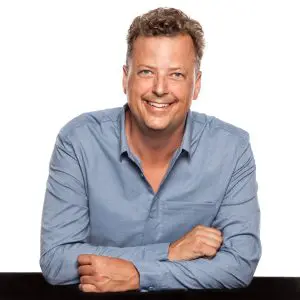
" Good team building is good team learning, and when we're able to provide a great learning environment that aligns with the people in the room, then we can start to move the needle within the organization."- Tyler Hayden
Get more human resources and leadership advice.
Less drama? Greater teamwork and job satisfaction? TeamBonding is here to help you build a stronger and happier team. Subscribe to get our team building podcast and thought leadership blogs sent straight to your inbox.
